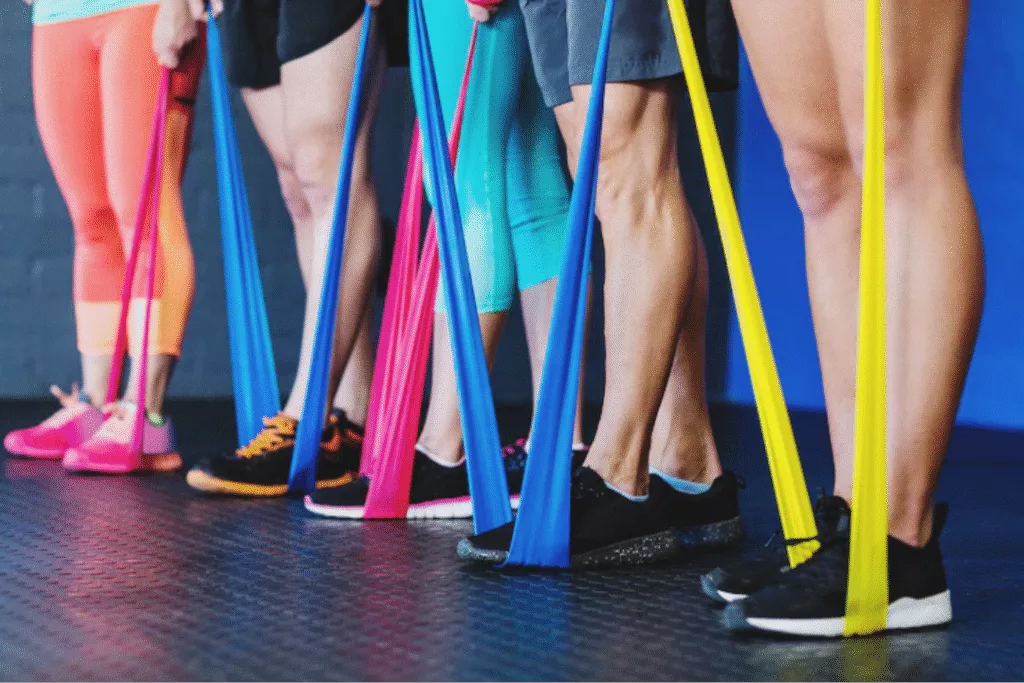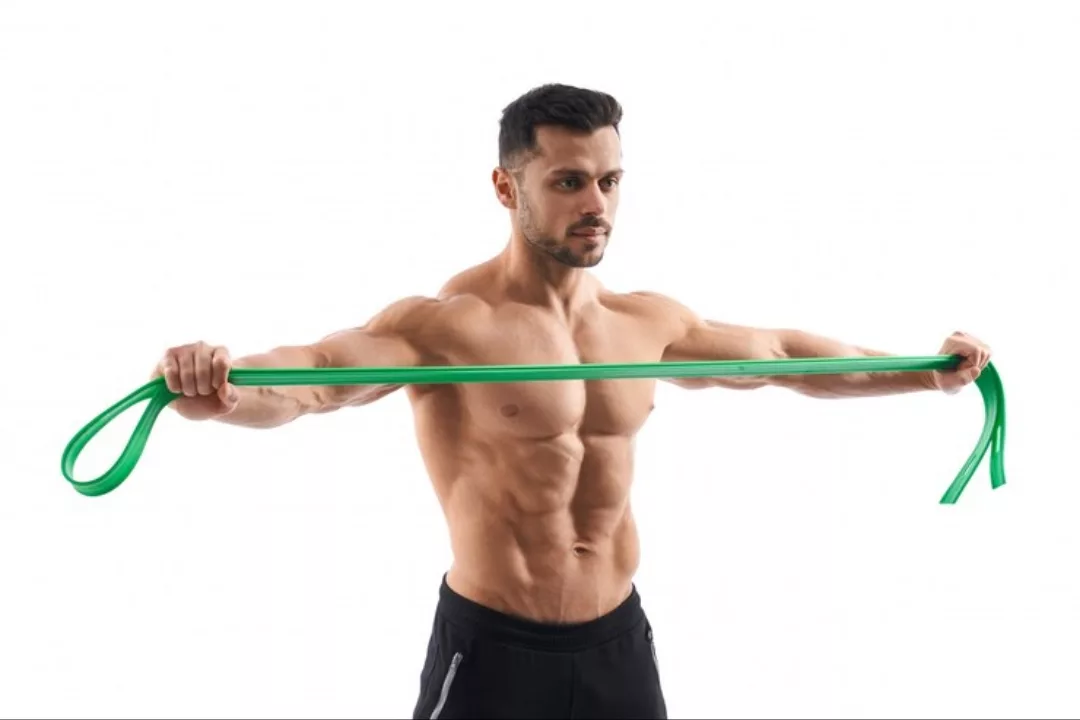I’ll tell you the truth: when I see someone in the gym pulling and letting go of a resistance band with a serious face, I can’t help but wonder if they’re trying to build muscle…
…or tame an invisible boa constrictor.
For years I viewed resistance bands the way I viewed zucchini at age ten: with suspicion and a hint of disdain.
Then, as often happens, karma showed up.
A little shoulder tweak, a physio armed with a smile and a red band, and that’s when I realized: resistance bands are seriously underrated.
But… can they actually help you build shoulder mass,
or are they just good for “staying upright like Uncle Bob after a few too many beers at Thanksgiving?
The Paradox of the Resistance Band: Colorful but Treacherous

At first glance they look harmless.
Light.
Colorful.
Perfect for Instagram pics or letting your dog play with them.
Yet when you actually use them… they stare you down and whisper, “Today I’m going to wreck your shoulders… in a good way.”
The reason is simple: the resistance of the band changes as you stretch it.
Translation: the more you pull, the more it hates you.
And that variable resistance forces your deltoids to work where they would normally relax.
At the hardest point.
Right where a dumbbell sometimes “dies” and you start to wobble.
A Touch of Science
Studies say some interesting things.
For example, research published in the Journal of Strength and Conditioning Research measured muscle activation during exercises done with bands versus those done with weights.
Result?
Activation levels were similar.
Your muscle basically can’t tell if you’re lifting a 10-kilogram dumbbell or pulling on a green band until your ears start to ring.
So yes, bands can stimulate muscle growth.
But… there’s a but.
The Resistance Band Bodybuilder Myth & Progressive Overload

Dreaming of rounded shoulders like bowling balls?
The kind that make every T-shirt look two sizes smaller?
Perfect.
Let’s be real.
With bands alone… you’ll hardly get there.
Or at least, not quickly.
Not because they’re useless—far from it!
But because building serious muscle mass requires progressive overload, and achieving that with bands is trickier than with dumbbells or barbells.
With iron you just add a couple of plates.
With a band?
You have to get creative.
But don’t get me wrong: it’s not impossible.
You can achieve overload with bands—you just have to think outside the box.
Here’s how you can ramp up the stimulus with resistance bands:
- Choose thicker bands = more resistance
- Increase stretch by stepping farther apart or pre-tensioning the band
- Slow down the time under tension (3-second concentric and 3-second eccentric = pure fire)
- Add isometric pauses at the toughest points of the movement
- Increase total volume (more sets, more reps, less rest)
In short: yes, you can progress with bands.
But it’s a more technical, less immediate path.
And here’s the key point: there’s room to grow, but it’s not infinite.
At some point you might find yourself doing shoulder presses with three bands at once—one anchored to the door, one under your feet, one tied to your roommate’s ankle…
…and that’s when you realize maybe it’s time to throw some real weights into the mix.
The risk is hitting a plateau.
That moment when the muscle adapts and stops growing.
And you can’t keep cranking up tension forever, because bands have physical limits (and so do you, unless you want to launch yourself like a broken slingshot).
Where Resistance Bands Shine

Here’s where bands become true superheroes:
- Joint warm-up (hello, rotator cuff)
- Targeted muscle activation (waking up those rear delts that have been snoozing since ’99)
- “Joint-friendly” workouts for creaky shoulders
- Continuous tension in exercises where there’s usually a dead spot
Think lateral raises with a band: at the top, where a dumbbell gets easy, the band squeezes you mercilessly.
Or banded face pulls: one of the most overlooked, magical exercises for building the posterior deltoids and preventing injuries.
The Perfect Mix: Bands + Iron
Out there you’ll hear “only weights!” or “only bodyweight!”
I say: mix it up, brother.
Do the heavy lifting with weights, sure.
But finish the session with a shoulder-burn circuit using bands.
Killer example:
Push press + banded lateral raises + banded face pulls
Repeat 3 ruthless rounds.
Then come back and tell me how you feel.
Bands help you:
- Refine shape
- Add volume without joint stress
- Correct imbalances
- Pump blood in all the right spots
And if you’re traveling?
Stash a band in your suitcase and you can get a decent workout anywhere—even in a hotel room the size of a trunk.
My Resistance Band Confession
Confession time.
Years ago I injured my shoulder doing an overhead press with all my heart… but zero brain.
From there, a long stint of bands and physical therapy.
I thought my dreams of gladiator shoulders were over.
But…
After endless face pulls, extensions, and band pull-aparts…
I ended up with shoulders that are rounder, more responsive, and healthier.
Now I always use them.
Not as the star of the show, but as those supporting characters that save the movie.
Exercise Examples for Shoulders with Bands
All resistance-band shoulder exercises, explained so you can do them tomorrow morning:
- Banded Overhead Press
Feet on the band, handles at shoulder height, palms forward.
Press overhead until arms are fully extended.
Control the descent.
Focus: anterior deltoids & stabilization - Lateral Raises
Feet on the band, handles in hand.
Slightly bend arms, lift laterally to shoulder height.
Brief pause, then return slowly.
Focus: lateral deltoids - Front Raises
Same setup, but lift in front of you, not to the side.
Don’t go above eye level.
Focus: anterior deltoids - Banded Face Pulls
Anchor band to a rack or door.
Pull to your face with wide elbows.
Squeeze shoulder blades.
Focus: posterior deltoids & cuff - Rear Delt Fly
Hold the band straight in front of you at shoulder height, arms extended.
Pull the band apart sideways into a “T” position, squeezing your shoulder blades together.
Control the return to start.
Focus: posterior deltoids - Shoulder External Rotation
Perfect for the cuff.
Anchor the band at waist height.
Stand sideways to the anchor, elbow bent at 90 degrees, tucked at your side.
Rotate your forearm outward against the band’s resistance.
Focus: rotator cuff muscles & injury prevention - Shoulder Isometric Hold
Stand on the band, hold the handles.
Lift your arms laterally to shoulder height and hold the position under tension.
Keep the core tight and resist movement.
Focus: endurance & control
Can You Train the Whole Body with Bands?
Oh, absolutely.
And I’ll tell you more: you can have a brutal full-body session with just a band.
Legs:
- Banded squats
- Lunges
- Banded hip thrusts
- Side walks (ninja-duck style)
- Romanian deadlifts (band under feet)
Core:
- Russian twists (band anchored)
- Anti-rotation (Pallof press style)
- Crunches with resistance
- Leg raises with band at feet
Chest & Back:
- Banded chest press
- Chest fly
- Horizontal rows
- High-anchor lat pull-downs
Arms:
- Bicep curls
- Overhead tricep extensions
- Tricep kickbacks
In short, you can do it all.
The only difference is you must pay even more attention to control, form, and progression.
But if you do it right… sweat is guaranteed.
RELATED:》》》Elastic Band Workouts: 13 Progressive Routines for Beginners to Pros + Advantages
What Results Are Truly Achievable?
Let’s be honest.
If you’re a beginner, bands are magic.
They give you:
- Motor control
- Functional strength
- Early muscle gains
- Stability
- All with lower injury risk
For intermediates?
They’re an excellent tool for extra volume, finishers, deload days, and focused work.
Advanced lifters?
That’s where the story gets thinner.
Bands don’t replace the big lifts but complement them.
An experienced athlete can use them for:
- Targeted activation (smart warm-ups)
- Final pumps & refinements
- Alternative deload workouts
- Muscle maintenance on the road or during rehab
In summary: yes, you can see visible results.
But context matters.
They’re not everything, but they’re an essential slice of the muscle-building buffet.
The Final Verdict
Yes.
Resistance bands are absolutely necessary.
No, they won’t build IFBB-level shoulders by themselves.
But they’re crucial for laying solid foundations, stabilizing joints, and refining details that weights often neglect.
They’re versatile, affordable, easy to use anywhere, and reward those who respect them.
If you want shoulders that are strong, mobile, visually impressive, and functionally powerful…
…don’t ignore resistance bands.
They’re not the main course.
But they’re the seasoning that makes the meal memorable.
So stop underrating them.
Add them to your arsenal.
And get your shoulders ready.
Because the band pump?
You’ll never forget it again.

